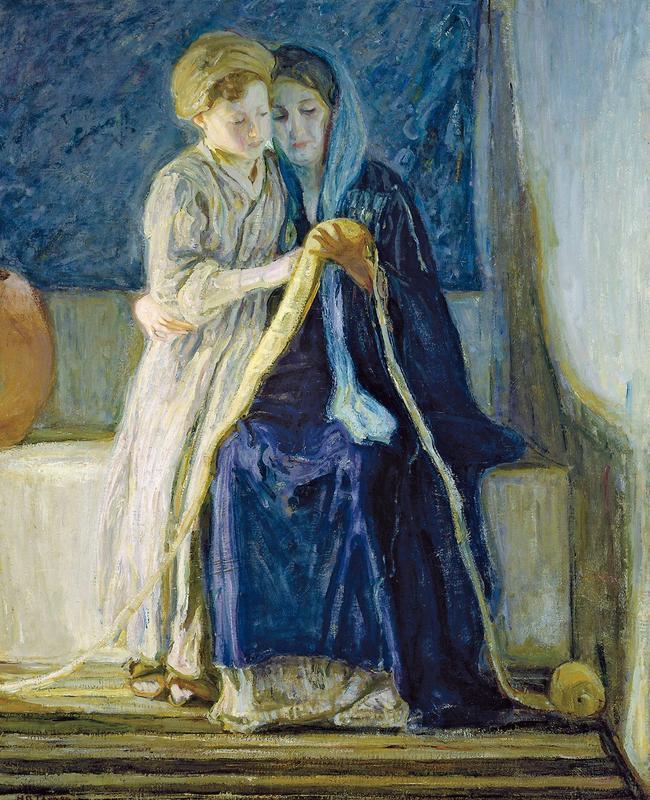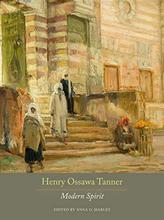More about Christ and His Mother Studying the Scriptures
- All
- Info
- Shop

Contributor
Tanner used his wife Jessie and his child Jesse (oh boy, that must get confusing at times) as models for this painting, using a photograph as reference.
Jesse was around the age of 6-8, usually the time when most children would begin to learn how to read. How they managed to keep him still enough for a photograph with great interest on a blank piece of paper, only history knows. Nevertheless, it served to make the piece more intimate and relatable, especially compared to previous depictions of Mary and Jesus, which depicted the latter as a baby. That worked for the ordinary layman back in the Renaissance, not so much in the more rational, technologically advanced world of the 1910s.
As a relatively modern painter of religious subjects, Tanner was saddened by the lack of artistic skill and merit in sacred art in his day. He stressed that such work must always be first successful as an earthly work of art before it can be successful as a work of religious significance. If only the regular church-goer would actually take his words to heart, we may have been saved that botched restoration attempt in Spain in 2012.
By 1909-1910, Tanner was at the peak of his career both in France and in America, enjoying patronage unheard of for an African-American, especially on both the domestic and international fronts. By this date, Tanner had forgone Philly cheesesteaks, baseball, and the racial tensions of his home country for the sweeter confectionaries and bigger opportunities of Paris, living there as an expatriate. Success came easier to him there, where instead of being seen first as a black man, people would simply identify him as the accomplished artist, “M. Tanner.”
The previous owner of this piece, Edgar J. Kaufmann, was attracted to Tanner’s spirituality, but he is most known in history as the owner and commissioner of Falling Water, Frank Lloyd Wright’s most iconic architectural work. Kaufmann was also the owner of Kaufmann’s Department Stores, an long-lived East Coast department store chain that was founded in 1871 and acquired by Macy’s in 2006.
Sources
- Chu, Christie. 2016. “Botched Restoration of Jesus Fresco Miraculously Saves Spanish Town.” Artnet News. artnet News. December 28, 2016. https://news.artnet.com/art-world/botched-restoration-of-jesus-fresco-m….
- Harvey, Eleanor James. 1997. “Christ and His Mother Studying the Scriptures.” DMA Collection Online. Dallas Museum of Art. 1997. https://collections.dma.org/artwork/5000380.
- Jessie Olssen Tanner and Jesse Ossawa Tanner Posing for Henry Ossawa Tanner's Painting Christ and His Mother Studying the Scriptures. 1910. Photograph. Archives of American Art, Smithsonian Institution. Washington, D.C.: Smithsonian Institution. Smithsoni
- Lindeman, Teresa. 2005. “Mega Buyout: Lazarus-Macy's Owner Acquiring Kaufmann's Parent for $11 Billion.” Pittsburgh Post-Gazette. Pittsburgh Post-Gazette. February 28, 2005. https://www.post-gazette.com/business/businessnews/2005/02/28/Mega-buyo…
- Romaine, James. n.d. “The Reality and Mystery of Christ's Incarnation.” ArtWay.eu. Accessed December 4, 2018. http://www.artway.eu/content.php?id=2477&lang=en&action=show.













I love this painting! I really appreciate the realistic feeling of this painting; obviously I have no idea what Mary and Jesus would have looked like together, but this gives me a glimpse of the relationship between Mary and young Jesus. I like the simplicity of this painting; it stood out in stark contrast to the other paintings around it. This is because most of the other paintings with Jesus or Biblical characters in them were painted during the Renaissance. This one was painted during the 1900s. It is interesting to me how you can see the differences in time periods in paintings. I also like the texture of the strokes in this painting. The painting has an almost streaky look to it that is very beautiful. This is another technique that is not seen in Renaissance Biblical paintings.